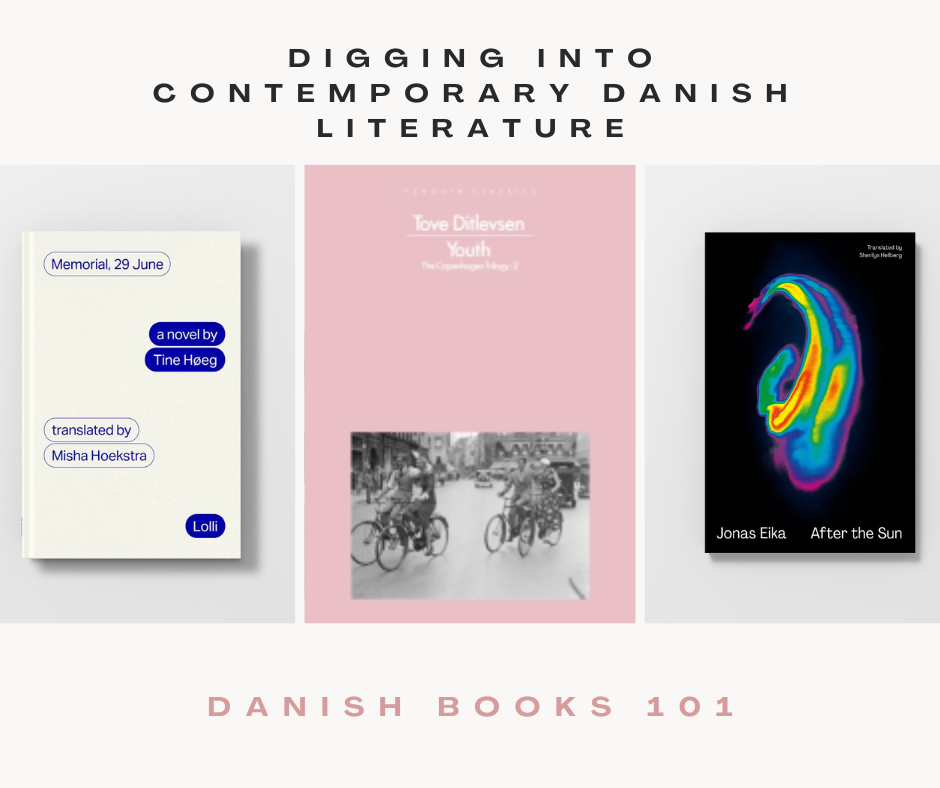Danish Books 101
I believe that contemporary Danish literature holds a great potential within the global literary scene, boasting talented and original writers. Particularly, there are exceptional young women writers who are pioneers of contemporary Danish literature these days in the literary scene.
Digging into Contemporary Danish Literature
As you may have already realised from my previous blogs, I am quite a nerd when the topic comes to Danish culture and art. While studying Visual Anthropology, and my pre-existing interest in Nordic culture come together, the catalysing effect for my interest is inevitable. I believe that contemporary Danish literature holds a great potential within the global literary scene, boasting talented and original writers. Particularly, there are exceptional young women writers who are pioneers of contemporary Danish literature these days in the literary scene.
What I generally find interesting as a literary writing style is, prose holds a significant place in the Danish literature these days. Prose as a writing style gets more and more common in literature, which reflects natural flow of speech in text.
Many young Danish authors write their book in prose novel-style. Some of them bland a style mixed with prose and regular novel. As I am learning and trying to engage myself in reading books in Danish, this way of writing was a great start for me.
In this blog, I would like to talk about four author and books that I specifically like reading very much from the contemporary Danish Literature. The publishing house Lolli Editions is active in translating Danish pieces into English.

Tine Høeg – Memorial, 29 June (translated by Misha Hoekstra, Lolli Editions)
One of the contemporary authors that I find very joyful and interesting to read is definitely Tine Høeg. She is definitely very into prose-style, therefore has very nice and easy to read books. What I really like about Tine Høeg is, she uses daily elements and details in her book and makes a writing out of it. While I was reading the book, there were several instances that made me think “I am happy to read this book after moving to Denmark” since I have gotten more acquainted with daily life after actually living in the country.
Høeg’s book titled Memorial, 29 June is about friendship, loss and grieving. The main character Asta receives an invitation to attend a memorial event, marking the ten-year anniversary of her university friend August's passing. This invitation brings about a disruption in her life, affecting both her work on a novel and her friendship with Mai and Mai's two-year-old son. As a result, Asta's longings, doubts, and memories of past parties resurface, breathing new life into her consciousness. Gradually, a different story begins to take shape—one that deviates from Asta's original intention to write about an obscure Polish sculptor. Instead, it centers around the events that truly unfolded on the night of August's death and the vibrant, stolen days leading up to that fateful moment. The book deals with being in our twenties, anxieties, ambitions, friendship and memories. It is a book about being a young adult and dealing with the surprises that life brings.
Jonas Eika – After the sun
It is clear that, Jonas Eika is one of the brightest Danish literature at the moment. After winning the Nordic Council Literature Prize in 2019, Eika insistingly received recognition from the literary milieu. In 2022, he was nominated for the International Booker Prize.
Eika introduces four different complex stories in his book about relationships, break ups, jealousy. He preoccupies with men’s relations and how they express their relations. Each history takes place in a different geography such as Copenhagen, Cancún, London and Nevada desert.
After the Sun unveils gateways to our latest realities, lingering on the fringes of a globalized world characterized by a blend of intense longing and ruthlessly transactional exchanges. Eika's fiction is imbued with an irresistible sense of urgency, as if conjuring these diverse characters and their interactions in a single exhale. By juxtaposing astonishing beauty with unsettling grotesquery and finding equilibrium between hyperrealism and the fantastical, Eika has forged innovative storytelling methods suitable for an era that demands fresh narratives in the face of outdated ones that have lost their relevance.
Tove Ditlevsen – The Copenhagen Trilogy
The very first Danish author I met was, Tove Ditlevsen. She is an iconic figure for Danish culture and literary scene, representing and giving voice to liberation of women, women’s experience with depression and their relation to men. Ditlevsen always deals with women’s liberation from men and breathing finally again after the separation. Quite controversial to her epoch, Ditlevsen have been primarily engaging with feminist literature with her work in from the 1940s to the 1970s.
Copenhagen Trilogy marks a very personal and autobiographical series in comparison to author’s other works. The series starts with the book Childhood, where Ditlevsen describes her childhood, the conditions of working-class family in Copenhagen, and portrays a panorama of Copenhagen – to-go places and to avoid places. In the second book, Youth, she tells about her teenage years and draws a portrait of being a young person in Denmark. What I really like about this trilogy is that, Ditlevsen captures very important and historical details about the timeframe and gives us an opportunity to compare Denmark’s past and now. From an international’s perspective, I think that; it is quite lovely to read about that epoch.
In the last book Dependency, she talks about her marriage, women’s relation to men, and yet women’s liberation. In that regard, the book is deeply inspired by the zeitgeist of feminist theory.
